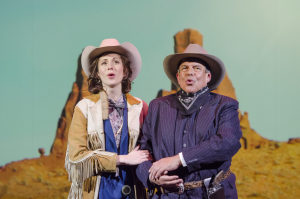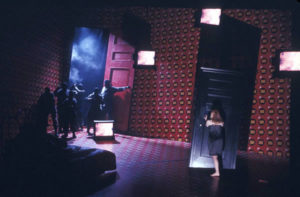
Opera thrives on iconic figures, whether from mythology or history. But maybe composer Arnold Schoenberg (1874-1951) hasn’t been gone long enough – or was never outwardly heroic enough – to fill Tod Machover’s new opera Schoenberg in Hollywood, premiered Nov. 14-18 by Boston Lyric Opera.
Schoenberg was the springboard for modernism in the second half of the 20th century; though he died in 1951, he cuts a Moses-like figure, leading serious music beyond atonality, creating a system by which its complete freedom could be managed, and taking the bullets that come with extreme originality but never seeing the promised land himself.
Schoenberg left Europe amid growing anti-Semitic unrest, landing, incongruously, in Los Angeles (he got a professorship at UCLA) amidst so many artist refugees, many working in the movie industry, that the city became known as the place where geniuses go to die.
Schoenberg’s mid-1930s arrival roughly coincided with that of Erich Wolfgang Korngold, who simply applied his well-upholstered Austrian opera sensibility to the film Captain Blood and the rest is, well, John Williams. So the meeting between studio mogul Irving Thalberg and Schoenberg wasn’t unthinkable. Legend has it that Schoenberg stated that he would require a year to write any film score – no doubt knowing that typical industry deadlines were more like six weeks or less. The encounter between these two unlikely creatures is like the brief intersection of Elvis Presley and Richard Nixon: Hugely intriguing, but is there a second act to be found somewhere in there?
Schoenberg in Hollywood – performed at the Emerson Paramount Center, whose art deco styling couldn’t be a better place for a tale of Old Hollywood – did indeed imagine a second act, but those further developments came at great cost, in terms of both the computer-animated production and narrative integrity.
The idea was to tell Schoenberg’s story through various Hollywood genres; the tactic was to show Schoenberg, the severe musical prophet, impersonating various Hollywood figures, from Groucho Marx to Superman. A tricky, idiosyncratic scenario to say the least, and one devised by the respected director Braham Murray, who was slated to stage the production but passed away over the summer. It’s hard to know what rabbits he had in the hat for this show, though a director of his reputation was sure to have them. One doesn’t suggest such a scenario without having a vision of how it’s going to work – or at least the foresight to know when Plan A isn’t doing what was intended, and that a more viable Plan B is needed. My guess is that Schoenberg in Hollywood might’ve become a sort of dreamy, hazy succession of music and images similar to Tania, Anthony Davis’s loose dramatization of the Patty Hearst kidnapping.

What actually got onstage was bewildering – not exactly a failure so much as a partial vision. Simon Robson’s libretto is a series of events from the life of Schoenberg, told mostly in flashbacks, full of behavior but without much characterization. Thus, the story’s episodes were enacted but never got you close to a real or imagined version of Schoenberg or any of the other figures onstage.
Though the opera had many characters in addition to Schoenberg, they were all played by two singers , a man and woman; they portrayed figures in the executive offices of powerful Hollywood studios as well as people from Schoenberg’s Old-World life, such as Wife No. 1 and the man with whom she was unfaithful. The many settings and time periods were depicted using black-and-white movies within the opera, all produced by media designer Peter Torpey with a sharp eye for the movie genres they were riffing on.
With all these ingredients, wild incongruity was obviously meant to be the main source of humor. But why was I not laughing? Why was I cringing? Why were few people around me laughing? At least at the closing performance, there was a sense that we were seeing an egg being laid onstage.
With so little real substance to work with, the singers – Omar Ebrahim as Schoenberg, plus Jesse Darden and Sara Womble as everybody else – were rarely convincing. They announced who they were, changed costumes every few minutes, and delivered stray lines about anti-Semitism to remind you this refugee story has a political backbone.
But even at its most dramaturgically hobbled, each scene had just enough insight to keep you from giving up altogether. Two scenes spoke to me. One of them utilized actual Schoenberg home movies, which gave the opera badly-needed veracity. The other was about the creation of Pierrot Lunaire, an early, seminal Schoenberg work whose creation was rightly dramatized as an act of supreme creative daring, treated with respectful seriousness amid the something/anything free-for-all that was the rest of the opera.
Elsewhere, most of those effects were gags without meaning, which made them gleefully trivial: they didn’t tell you anything about the movie genres at hand and (the home movies aside) delivered not the slightest insight into Schoenberg. Again, the original director might’ve made all the difference; the choreographer Karole Armitage stood in for him, perhaps with too much blind faith in the original scenario.
Periodically, I tuned out the production and focused on Machover’s score, which almost made the 90-minute piece worthwhile. His works often have a chameleon-like quality dictated by the subject matter at hand. And here, his music gave the impression of Schoenbergian atonality but without spiky edges. Distinctive coloristic effects gave an often-delicate tint to each scene, almost in the spirit of a cinematographer. When Machover needed extra dramatic weight, he employed electronic sound that intensified the instrumental writing and occasionally took over completely, with great effect. Occasional reference to pop tunes like “Happy Trails” felt appropriate.
Even though Machover has the wit and irony needed for a scenario like this one, the territory might’ve been more fruitfully explored by the likes of composer Michael Daugherty, who has long found gravitas in American pop culture. Machover’s best works, his concertos for electronically augmented instruments – and they’re pretty great – had him collaborating with technology and not a lot of other outside creative forces. Maybe he’s a too-accommodating collaborator. Maybe it’s time for him to shine, once again, on his own.

